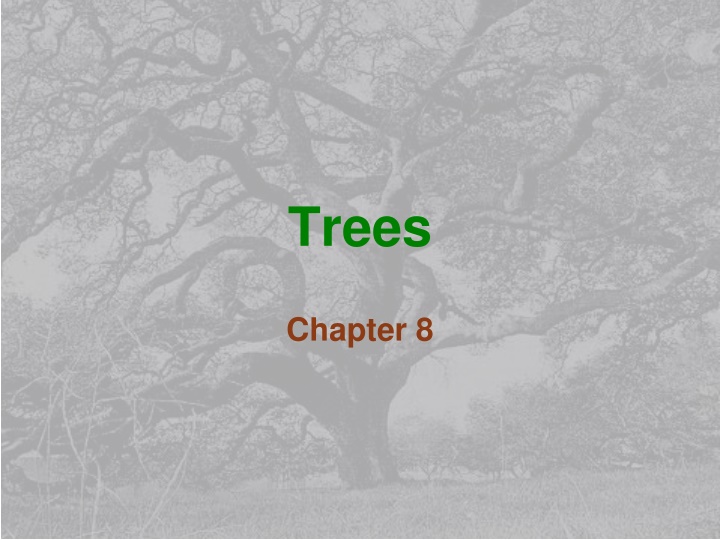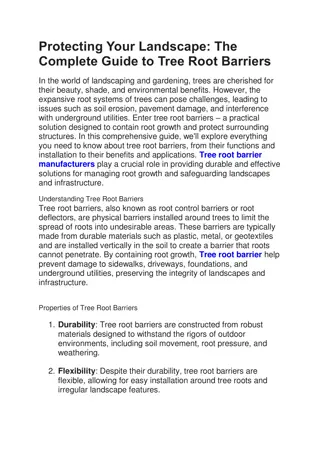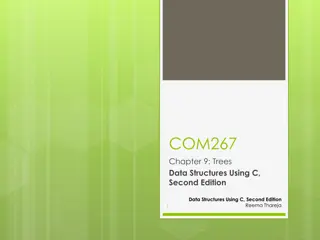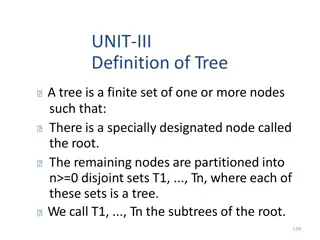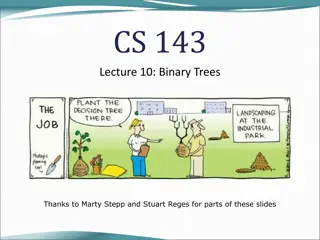Tree Structures in Computer Science
Tree structures play a vital role in computer science, representing hierarchical relationships and providing efficient solutions to various problems. From basic definitions to advanced terminologies, this content delves into the world of trees, graphs, and rooted trees, offering insights into their applications and formal definitions. Learn about traversal techniques, binary trees, graph representations, and more.
Download Presentation

Please find below an Image/Link to download the presentation.
The content on the website is provided AS IS for your information and personal use only. It may not be sold, licensed, or shared on other websites without obtaining consent from the author.If you encounter any issues during the download, it is possible that the publisher has removed the file from their server.
You are allowed to download the files provided on this website for personal or commercial use, subject to the condition that they are used lawfully. All files are the property of their respective owners.
The content on the website is provided AS IS for your information and personal use only. It may not be sold, licensed, or shared on other websites without obtaining consent from the author.
E N D
Presentation Transcript
Trees Chapter 8
Outline Definitions Traversing trees Binary trees
Outline Definitions Traversing trees Binary trees
Graph a b Node ~ city or computer Edge ~ road or data cable c Undirected or Directed A surprisingly large number of computational problems can be expressed as graph problems.
Directed and Undirected Graphs (a) A directed graph G = (V, E), where V = {1,2,3,4,5,6} and E = {(1,2), (2,2), (2,4), (2,5), (4,1), (4,5), (5,4), (6,3)}. The edge (2,2) is a self-loop. (b) An undirected graph G = (V,E), where V = {1,2,3,4,5,6} and E = {(1,2), (1,5), (2,5), (3,6)}. The vertex 4 is isolated. (c) The subgraph of the graph in part (a) induced by the vertex set {1,2,3,6}.
Trees Tree Forest Graph with Cycle A tree is a connected, acyclic, undirected graph. A forest is a set of trees (not necessarily connected)
Rooted Trees Trees are often used to represent hierarchical structure In this view, one of the vertices (nodes) of the tree is distinguished as the root. This induces a parent-child relationship between nodes of the tree. Applications: root Organization charts Computers R Us File systems Programming environments Sales Manufacturing R&D US International Laptops Desktops Europe Asia Canada
Formal Definition of Rooted Tree A rooted tree may be empty. Otherwise, it consists of A root node r A set of subtrees whose roots are the children of r r B C D E F G H subtree I J K
Tree Terminology Root: node without parent (A) Internal node: node with at least one child (A, B, C, F) External node (a.k.a. leaf ): node without children (E, I, J, K, G, H, D) Ancestors of a node: self, parent, grandparent, great-grandparent, etc. NB: A node is considered an ancestor of itself! Descendent of a node: self,child, grandchild, great-grandchild, etc. A NB: A node is considered a descendent of itself! Siblings: two nodes having the same parent Depth of a node: number of ancestors (excluding the node itself) Height of a tree: maximum depth of any node (3) Subtree: tree consisting of a node and its descendents B C D E F G H I J K subtree
Outline Definitions Traversing trees Binary trees
Traversing Trees One of the basic operations we require is to be able to traverse over the nodes of a tree. To do this, we will make use of a Position ADT.
Position ADT The Position ADT models the notion of place within a data structure where a single object is stored It gives a unified view of diverse ways of storing data, such as a cell of an array a node of a linked list a node of a tree Just one method: object p.element(): returns the element stored at the position p.
Tree ADT We use positions to abstract the nodes of a tree. Query methods: Generic methods: boolean isInternal(p) integer size() boolean isExternal(p) boolean isEmpty() boolean isRoot(p) Iterator iterator() Update method: Iterable positions() object replace(p, o) Accessor methods: Additional update methods may be defined by data structures implementing the Tree ADT Position root() Position parent(p) Iterable children(p)
Positions vs Elements Why have both Iterator iterator() Iterable positions() The iterator returned by iterator() provides a means for stepping through the elements stored by the tree. The positions() method returns a collection of the nodes of the tree. Each node includes the element but also the links connecting the node to its parent and its children. This allows you to move around the tree by following links to parents and children.
Preorder Traversal A traversal visits the nodes of a tree in a systematic manner AlgorithmpreOrder(v) visit(v) foreach child w of v preOrder (w) Each time a node is visited, an action may be performed. Thus the order in which the nodes are visited is important. In a preorder traversal, a node is visited before its descendants 1 Make Money Fast! 2 5 9 1. Motivations 2. Methods References 6 7 8 3 4 2.3 Bank Robbery 2.1 Stock Fraud 2.2 Ponzi Scheme 1.1 Greed 1.2 Avidity
Postorder Traversal In a postorder traversal, a node is visited after its descendants AlgorithmpostOrder(v) foreach child w of v postOrder (w) visit(v) 9 cs16/ 8 3 7 todo.txt 1K homeworks/ programs/ 4 5 6 1 2 Robot.java 20K h1c.doc 3K h1nc.doc 2K DDR.java 10K Stocks.java 25K
Linked Structure for Trees A node is represented by an object storing Element Parent node Sequence of children nodes B Node objects implement the Position ADT A D F B D A F C E C E
Outline Definitions Traversing trees Binary trees
Binary Trees A binary tree is a tree with the following properties: Applications: arithmetic expressions Each internal node has at most two children (exactly two for proper binary trees) decision processes searching The children of a node are an ordered pair A We call the children of an internal node left child and right child B C D E F G H I
Arithmetic Expression Tree Binary tree associated with an arithmetic expression internal nodes: operators external nodes: operands Example: arithmetic expression tree for the expression (2 (a 1) + (3 b)) + 2 3 b a 1
Decision Tree Binary tree associated with a decision process internal nodes: questions with yes/no answer external nodes: decisions Example: dining decision Want a fast meal? No Yes How about coffee? On expense account? Yes No Yes No Second Cup Blueberry Hill Canoe Cafe Diplomatico
Proper Binary Trees A binary tree is said to be proper if each node has either 0 or 2 children.
Properties of Proper Binary Trees Notation Properties: n number of nodes e = i + 1 e number of external nodes n = 2e - 1 i number of internal nodes h i h height h (n - 1)/2 e 2h h log2e h log2(n + 1) - 1
BinaryTree ADT The BinaryTree ADT extends the Tree ADT, i.e., it inherits all the methods of the Tree ADT Additional methods: Position left(p) Position right(p) boolean hasLeft(p) boolean hasRight(p) Update methods may be defined by data structures implementing the BinaryTree ADT
Representing Binary Trees Linked Structure Representation Array Representation
Linked Structure for Binary Trees A node is represented by an object storing Element Parent node Left child node B Right child node Node objects implement the Position ADT B A D A D C E C E
Implementation of Linked Binary Trees in net.datastructures Query Methods: Modification Methods: Tree<E> size() replace(p, e) isEmpty() addRoot(e) isInternal(p) BinaryTree<E> insertLeft(p) isExternal(p) insertRight(p) isRoot(p) LinkedBinaryTree<E> remove(e) hasLeft(p) hasRight(p) root() left(p) right(p) parent(p) children(p) sibling(p) positions() iterator()
BTPosition in net.datastructures The implementation of Positions for binary trees in net.datastructures is a bit subtle. BTPosition<E> is an interface in net.datastructures that represents the positions of a binary tree. This is used extensively to define the types of objects used by the LinkedBinaryTree<E> class that LinkedBinaryTreeLevel<E> extends. You do not have to implement BTPosition<E>: it is already implemented by BTNode<E>. Note that LinkedBinaryTree<E> only actually uses the BTNode<E> class explicitly when instantiating a node of the tree, in method createNode. In all other methods it refers to the nodes of the tree using the BTPosition<E> class (i.e., a widening cast). This layer of abstraction makes it easier to change the specific implementation of a node down the road it would only require a change to the one method createNode. We use BTPosition<E> in testLinkedBinary to define the type of father, mother, daughter and son, and to cast the returned values from T.addRoot, T.insertLeft and T.insertRight. These three methods are implemented by LinkedBinaryTree and return nodes created by the createNode method. In LinkedBinaryTreeLevel, you can use the BTPosition<E> interface to define the type of the nodes stored in your NodeQueue. These nodes will be returned from queries on your binary tree, and thus will have been created by the createNode method using the BTNode<E> Class. Position<E> LinkedBinaryTree public hasLeft (p) public hasRight (p) BTPosition<E> protected createNode (e, parent, left, right) BTNode<E>
Array-Based Representation of Binary Trees nodes are stored in an array, using a level-numbering scheme. 1 A 2 3 B D let rank(node) be defined as follows: 4 5 6 7 rank(root) = 1 J C E F if node is the left child of parent(node), rank(node) = 2*rank(parent(node)) 10 11 if node is the right child of parent(node), rank(node) = 2*rank(parent(node))+1 G H
Comparison Linked Structure Requires explicit representation of 3 links per position: Array Parent and children are implicitly represented: Lower memory requirements per position parent, left child, right child Memory requirements determined by height of tree. If tree is sparse, this is highly inefficient. Data structure grows as needed no wasted space.
Inorder Traversal of Binary Trees In an inorder traversal a node is visited after its left subtree and before its right subtree AlgorithminOrder(v) ifhasLeft (v) inOrder (left (v)) visit(v) ifhasRight (v) inOrder (right (v)) Application: draw a binary tree x(v) = inorder rank of v y(v) = depth of v 6 2 8 1 4 7 9 3 5
Print Arithmetic Expressions Specialization of an inorder traversal Algorithm printExpression(v) if hasLeft (v) print( ( ) inOrder (left(v)) print(v.element ()) if hasRight (v) inOrder (right(v)) print ( ) ) print operand or operator when visiting node print ( before traversing left subtree print ) after traversing right subtree Input: + Output: ((2 (a 1)) + (3 b)) 2 3 b a 1
Evaluate Arithmetic Expressions Algorithm evalExpr(v) if isExternal (v) return v.element () else x evalExpr (leftChild (v)) y evalExpr (rightChild (v)) operator stored at v return x y Specialization of a postorder traversal recursive method returning the value of a subtree when visiting an internal node, combine the values of the subtrees + 2 3 2 5 1
Euler Tour Traversal Generic traversal of a binary tree Includes as special cases the preorder, postorder and inorder traversals Walk around the tree and visit each node three times: on the left (preorder) from below (inorder) on the right (postorder) + L R B 2 3 2 5 1
Template Method Pattern Generic algorithm that can be specialized by redefining certain steps public abstract class EulerTour { protected BinaryTree tree; protected void visitExternal(Position p, Result r) { } protected void visitLeft(Position p, Result r) { } protected void visitBelow(Position p, Result r) { } protected void visitRight(Position p, Result r) { } protected Object eulerTour(Position p) { Result r = new Result(); if tree.isExternal(p) { visitExternal(p, r); } else { visitLeft(p, r); r.leftResult = eulerTour(tree.left(p)); visitBelow(p, r); r.rightResult = eulerTour(tree.right(p)); visitRight(p, r); return r.finalResult; } Implemented by means of an abstract Java class Visit methods can be redefined by subclasses Template method eulerTour Recursively called on the left and right children A Result object with fields leftResult, rightResult and finalResult keeps track of the output of the recursive calls to eulerTour
Specializations of EulerTour public class EvaluateExpression extends EulerTour { We show how to specialize class EulerTour to evaluate an arithmetic expression protected void visitExternal(Position p, Result r) { r.finalResult = (Integer) p.element(); } Assumptions External nodes store Integer objects protected void visitRight(Position p, Result r) { Operator op = (Operator) p.element(); r.finalResult = op.operation( (Integer) r.leftResult, (Integer) r.rightResult ); } Internal nodes store Operator objects supporting method operation (Integer, Integer) }
Outline Definitions Traversing trees Binary trees
